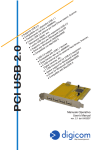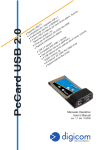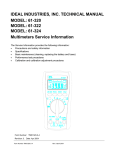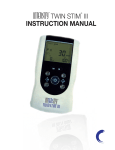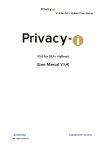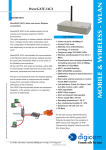Download Digicom Modem HDSL Ethernet
Transcript
HDSL User's Guide rev. 1.0 05/2000 http://www.digicom.it INDEX - DECLARATION CE OF CONFORMITY HDSL INDEX INTRODUCTION PREFACE III III 1. GENERAL 1.1. DESCRIPTION 1.2. FRONT PANEL VIEW 1.3. REAR PANEL VIEW 1.3.1. LINE CONNECTOR PIN 1.3.2. G.703 120 OHM CONNECTOR PIN 1.1 1.1 1.1 1.2 1.2 1.2 2. INSTALLATION 2.1. CONFIGURATIONS DESCRIPTION 2.1 2.1 DECLARATION CE OF CONFORMITY Digicom S.p.A. via Alessandro Volta 39 21010 Cardano al Campo -Varesedeclares that this product satisfies the basic requirements of Electromagnetic Compatibility and Safety of the below indicated Directive: l 89/336/CEE of 3 may 1989 with subsequent modifications (Directive 92/31/CEE of april 28, 1992, Directive 93/68/CEE of July 22,1993 and Directive 93/97/CEE of 29 october 1993). l 73/23/CEE of february 19, 1973 with subsequent modifications (Directive 93/68 ECC of july 22, 1993). I PREFACE HDSL INTRODUCTION Digicom’s HDSL modems uses the HDSL technology (High-bit-rate Digital Subscriber Line) that allows very high transfer speeds (2 Mbps) over leased lines. It is possible to connect Digicom’s HDSL modems either over 2 wires and 4 wires lines. The main requirement for a HDSL Lines is the wire metal continuity. PREFACE The following installation rules should be respected in order to have the best working order of the equipment and for the user's safety. Rapid changes of temperature or humidity should be avoided (0,03°C/min). This equipment, including cables, should be installed in an area free from: l Dust, humidity, heat from direct sun light. l Objects which irradiate heat. These could cause damage to the container or other problems. l Objects which produce a strong electtromagnetic field (loudspeakers, etc.) l Liquids or chemical corrosive substances. To avoid electric shock, the equipment should never be opened. Ask qualified personnel help. Disconnect the power cable from the wall outlet when the equipment is not to be used for a long period. To disconnect the cable pull it by the plug, never pull it by the cable itself. If there should be liquid or object penetration in the equipment, disconnect the power cable and call a qualified personl for testing. CLEANING THE TERMINAL Use a clean and soft cloth. Wet the cloth with water or natural detergent if it is necessary to remove any stains. Never use chemical products such as petrol or solvents. VIBRATIONS OR DROPPING Caution against vibrations and dropping. WARNING This is a class A product. In a domestic environment this product may cause radio interference in which case the user may be required to take adequate measures. III GENERAL HDSL 1. GENERAL 1.1. DESCRIPTION HDSL line 2/4 wires MASTER V3 5/G 70 3 M ST /S LV LO O P AL M LO C AL M R EM PW R LIN K2 HDSL HIGH SPEED MODEM RX LIN K1 V3 5/G 70 3 M ST /S LV LO O P AL M LO C AL M R EM HDSL PW R TX G.703/V35 LIN K1 LIN K2 TX G.703/V35 HIGH SPEED MODEM SLAVE RX Picture 1 The connection is carried out using 2 HDSL devices: one placed in the main centre (Master) and the other one in the remote place (Slave). The Master and Slave devices have different configurations but are equal as for the electric or mechanic features. All the digicom’s HDSL modems are supplied with the following factory configuration: l l l l l Master V.35 selected interface Two wires connection 256 Kbit/s line speed Internal clock LI N K2 V3 5/ G 70 3 M ST /S LV LO O P AL M LO C AL M R EM LI N K1 HDSL PW R 1.2. FRONT PANEL VIEW HIGH SPEED MODEM Picture 2 Name PWR LINK1 Color Green Red LINK2 Red V35/G703 Red MST/SLV Red LOOP Red ALM LOC Red ALM REM Red Condition Off On Flashing On Flashing Off On Off On Off On Flashing On Flashing On Function No power supply Channel 1 Status: Connected with the remote one Channel 1 Status: Searching Channel 2 Status: Connected with the remote one Channel 2 Status: Searching Channel 2 Status: disabled V.35 interface selection G.703 interface selection Device configured as Master Device configured as Slave Local Loop enabled Loop enabled on the remote device Problem with G.703 interface Fault on the local device Problem with the G.703 remote interface (managed on Master device only) Fault on the remote device Flashing 1.1 GENERAL HDSL 1.3. REAR PANEL VIEW V.35 G703 75Ω TX PWR CONFIG LINE RX 120 / 75Ω G703 120 Ω Picture 3 Name PWR CONFIG LINE G.703 120 ohm 120/75 ohm switch G.703 75 ohm TX G.703 75 ohm RX G.703 75 ohm switch V.35 Function Power supply 9pin female connector for device configuration HDSL line connector RJ11 4 contacts G.703 interface 120 ohm 9 pin female connector G.703 interface setup at 120 ohm or 75 ohm G.703 interface 75 ohm coaxial BNC (send) G.703 interface 75 ohm coaxial BNC (receive) Join the shield of coaxial connectors G.703 75 ohm V.35 interface, 25 pin female connector 1.3.1. LINE CONNECTOR PIN PIN 3 and 4 1 and 2 Signal HDSL Line 1 HDSL Line 2 1.3.2. G.703 120 OHM CONNECTOR PIN PIN 1 and 2 4 and 5 Signal Receive Send B A n.c. n.c. 4321 B 1.2 A 1B 2B 1A 2A 5B 6B 5A 6A RED BROWN PIN2 PIN1 WHITE BLUE PIN3 PIN4 INSTALLATION HDSL 2. INSTALLATION l l l l l Remove the two HDSL modems from the package and check they are OK. Using the “SetHDSL” program, configure one of the two modems as Slave. Connect the HDSL lines between the modems (RJ11 connector). Power on the modems that will connect using the factory configuration (default): V.35 selected interface two wires connection 256 Kbit/s line speed At this point from the Master place and using the “SetHDSL” program, it is possible to modify the system configuration to set the desired parameters. 2.1. CONFIGURATIONS DESCRIPTION To configurate the Digicom’s HDSL modems it is necessary to use the Digicom “SetHDSL” program. The user can choose among seven base configurations (A-G) depending on the interface, the wires of the line and the line speed. Case Interface A G703 Flow E1 Wires 4 B G703 E1 2 C G703 Nx64 2 D G703 Nx64 4 E V.35 Nx64 4 F V.35 Nx64 2 G V.35 Nx64 4 Interface/line speed Interface speed fixed at 2 Mbit/s Speed for each couple of wires 1 Mbit/s Interface speed fixed at 2 Mbit/s HDSL line speed 2 Mbit/s Interface speed Nx64 Kbit/s (from 64 to 2 Mbit/s) HDSL line speed depending on set time slot Interface speed Nx64 Kbit/s (from 64 to 2 Mbit/s) HDSL line speed depending on set time slot Interface speed Nx64 Kbit/s (from 64 to 2 Mbit/s) Speed for each couple of wires 1 Mbit/s Interface speed Nx64 Kbit/s (from 64 to 2 Mbit/s) HDSL line speed depending on set time slot Interface speed Nx64 Kbit/s (from 64 to 2 Mbit/s) HDSL line speed depending on set time slot NOTE: “N” is the time slot number (i.e. if time slot is 4, Nx64=256 Kbit/s) The base configuration (A-G) can be customized by setting the Framing type (G.703), the interface (V.35), the speed (tile slot number), the clock, etc. 1.1 INSTALLATION HDSL NOTE: For further and complete information on the “SetHDSL”, please refer to the program help on line. 1.2 INSTALLATION HDSL Interface speed [Kbit/s] 64 128 192 256 320 384 448 512 576 640 704 768 832 896 960 1024 (1Mbps) 1088 1152 1216 1280 1344 1408 1472 1536 1600 1664 1728 1792 1856 1920 1984 2048 (2Mbps) “N” Time Slot 1 2 3 4 5 6 7 8 9 10 11 12 13 14 15 16 17 18 19 20 21 22 23 24 25 26 27 28 29 30 31 32 Line speed for each couple of wire (4 wires) [Kbit/s] 272 272 272 272 272 272 272 272 336 336 400 400 464 464 528 528 592 592 656 656 720 720 784 784 848 848 912 912 976 976 1040 1040 1.3 Line speed (2 wires) [Kbit/s] 272 272 272 272 336 400 464 528 592 656 720 784 848 912 976 1040 1104 1168 1232 1296 1360 1424 1488 1552 1616 1680 1744 1808 1872 1936 2000 2064 21010 Cardano al Campo VA via A. Volta 39









